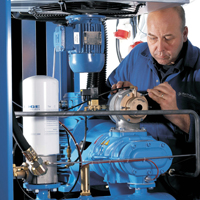 Understanding Compressed Air Production Costs
Understanding Compressed Air Production Costs
Businesses must look beyond the initial purchase price of a compressed air system and consider the factors that affect the total cost of ownership (TCO), explains Mark Whitmore, General Manager at BOGE. (Read More)
While purchasing a compressor may be the largest single one-off cost for businesses investing in compressed air production, operating the system will bring greater combined costs over its lifetime. It is in the best interests of businesses to ensure total cost of ownership is as low as possible to help the bottom line – with reduced energy bills and greater machine reliability two significant benefits.
Advertisement - Hover to see more
Advertisement - Hover to see more
Energy efficiency
The main expense throughout a compressor’s lifespan is the energy costs associated with operating the system, which accounts for approximately 75% of total costs across the machine’s life cycle – equalling more than the original price of the system. Of this, typical system inefficiencies such as leaks or supercharging result in around 55% of the input energy used to compress air being wasted.
However, this doesn’t have to be the case. Easy alterations can be made throughout the compressed air system to help cut the energy usage of compressors by up to 50%.
One option is to implement an intelligent energy management system. This provides a transparent and current picture of how efficiently the compressor is performing, helping to control costs and make savings of 30-50%.
Also, because a high proportion of energy used for air compression is converted into heat, there is an opportunity to reuse this energy elsewhere in the plant – to heat water, for example – to further improve efficiency and cut energy bills. A heat recovery system such as the BOGE DUOTHERM can recover up to 75% of the energy emitted for reuse, thus reducing utility bills as well as environmental impact.
Compressor maintenance
Failing to take care of a compressor appropriately can be an expensive mistake, with unexpected costs quickly adding up. Regular maintenance is therefore essential to preventing malfunctions that may reduce efficiency and increase the likelihood of machine failure.
There is more than one option when selecting the most appropriate maintenance programme. Fixed maintenance is pre-set, meaning components would be fixed, serviced or replaced after a certain amount of time, regardless of whether this was required or not. Status-based maintenance, on the other hand, is where systems are continuously monitored through the use of diagnostic tools, with action taken to repair or replace assets only when required.
As part of a thorough maintenance programme, businesses must also consider leak detection. The Carbon Trust estimates that a 3mm hole in a compressed air line could cost a business as much as £700 per year in wasted energy. Conducting leak detection surveys is a simple way of further lowering the total cost of ownership.
Summary
There is much more to owning and operating a compressor than the initial purchase price. By taking into account the various other factors that add to the cost of producing compressed air, businesses can make significant efficiency savings and improve machine reliability to avoid unscheduled downtime – much to the benefit of the bottom line.
For further information contact:
BOGE Compressors Ltd.
Rastrick Common
Brighouse, West Yorkshire, HD6 3DR
Mike Heeley
E-mail: This email address is being protected from spambots. You need JavaScript enabled to view it.
Tel: +44 14 84-719921
Fax: +44 (0) 1484 712516
www.boge.co.uk



